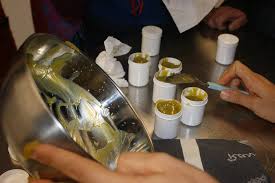Ointment
 Melt beeswax in a bain -marie and add sifted (herbs) oil.
Melt beeswax in a bain -marie and add sifted (herbs) oil.
To test whether the ointment has the right consistency, let a few drops fall into a bowl of cold water. Are they balls, you get a thick cream. Distribute they on the surface, it will be a thin cream. Do you want it thicker, add additional (petroleum jelly or) beeswax.
Cream
Would you like a cream, then you have to work with different emulsifiers because water and oil do not mix. It's like mayonnaise: take oil and vinegar, sometimes a little water and egg yolk as emulsifier. A cream has obviously a much shorter shelf life by this composition than a lipid-based ointment.
Add herbal oil, herbal tea or herbal tincture.
Lanolin
Lanolin is a water - oil emulsion (margarine -like) which mainly consists of waxes and appears as a yellow coat in wool near the skin. This sticky sebum protects the sheep well against rain, snow and wind. It may also (or not mixed with beeswax and (soybean) oil) be used in order to keep textile waterproof.
Wool wax has a melting point between 40-48°C, and is extracted by washing wool and then to evaporate the water. Thereafter, the fat is cleaned.
Combing out can also (partly). Industrially, it is often chemically extracted from the wool.
Wool grease can hold a lot of water and is used in ointments and creams: 2-5%, soap: 3-7%, balsam: 2-4%, hair conditioner: 3-6%. It protects the skin in a natural way, and still lets her breathe.
It pulls well in the horny layer of the skin, and is used to prevent diaper rash, stretch marks, cracked nipples, dry skin (and hair), as an anti - wrinkle agent, lip balm, hand and foot cream. Some heating makes it lubricating and fluid.
Wool fat can cause an allergic reaction.
Petroleum jelly ((white) petrolatum, soft paraffin ) is a white to yellowish ointment -like mass which is liquid between 40 and 60 degrees Celsius. It consists of hydrocarbons derived from petroleum, which are carcinogenic in unpurified form. It is resistant to the action of almost all chemicals, and is a good lubricant for plastics (hinges..). It contains mineral oil, paraffin and wax.
The purified form is neutral, has no effect but is used to cover eczema, skin burns... It does not pull in the skin, but covers it well (also against bacteria).
For marigold ointment (Calendula officialize) you can have 4 hands flowers simmer in 1/2l lard or oil. Leave one day covered. Re-heating, and casting through a filter cloth. More thickening may be yet to melt between 200 and 250gr beeswax and mixing.
Balsam means fragrant in Arabic. Balms are thin and viscous vegetable spreads with a strong characteristic odor, with resins and essential oils, often of the balsam trees (Burseraceae) containing fragrances like myrrh, frankincense and myrrh.
Melt on low heat 3 parts vegetable oil, 1 part beeswax and possibly one part butter to make lip balm. Add scented oils.
If you want to make cosmetic products above (or even soap)will do as useful neutral base or carrier. You can add oil to make the mixture softer. Melting and mixing is best done in a hot water bath.
Dyes that can be used:
For mascara or eyeliner: charcoal
Miscible pigments for lipstick:
beetroot powder, beetroot juice
seeds of a pomegranate
blueberries
cinnamon for a reddish-brown color
turmeric for a copper tint
cocoa powder for deep brown
charcoal to darken the color.
Keep your produce cool and not too long.
